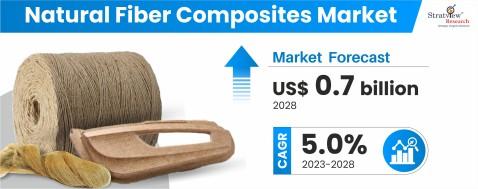The natural fiber composites (NFC) market is rapidly gaining traction as industries seek sustainable and environmentally friendly alternatives to traditional materials. These composites are made from natural fibers like flax, hemp, jute, and kenaf, combined with a polymer matrix, offering a greener option compared to conventional composites such as fiberglass or carbon fiber. As concerns over environmental impact and resource sustainability rise, the demand for natural fiber composites has grown across various sectors, including automotive, construction, and packaging.
"The natural fiber composites market is expected to reach a nearly US$ 0.7 billion valuation in 2028, exhibiting a healthy CAGR of 5.0% during 2023-28".
Key Drivers of Market Growth
Several factors are propelling the growth of the natural fiber composites market:
- Sustainability Push: One of the primary drivers is the increasing global emphasis on reducing carbon footprints and minimizing reliance on non-renewable resources. Natural fiber composites are biodegradable and often sourced from renewable materials, making them attractive for industries focused on eco-friendly products.
- Lightweight & Strong: Natural fiber composites offer an excellent strength-to-weight ratio, which is particularly beneficial in industries like automotive and aerospace, where weight reduction is critical for improving fuel efficiency and performance. In the automotive sector, for example, manufacturers are incorporating NFCs to lower vehicle weight, which leads to better fuel economy and reduced emissions.
- Cost-Effectiveness: Compared to synthetic fiber composites, natural fibers tend to be less expensive due to their renewable nature and lower processing costs. This makes them attractive to manufacturers looking to balance performance and cost-efficiency, especially in applications like packaging, consumer goods, and construction materials.
- Regulatory Support: Governments and international bodies are increasingly promoting sustainable materials by offering incentives for adopting eco-friendly technologies. This regulatory support is boosting the demand for natural fiber composites across industries, further accelerating market growth.
Challenges and Opportunities
Despite its potential, the natural fiber composites market faces challenges. One major hurdle is the variability in fiber quality, which can affect the consistency of the composite’s mechanical properties. Additionally, NFCs may not yet achieve the same level of performance as synthetic composites in extreme conditions.
However, ongoing research and development efforts are focused on improving fiber treatment techniques and hybrid composites that combine natural and synthetic fibers. This could open new opportunities for NFCs in high-performance applications, expanding their market share.
Conclusion
As sustainability becomes a central focus for industries worldwide, the natural fiber composites market is set for significant growth. With its eco-friendly advantages, cost-effectiveness, and versatility, NFCs are poised to play a key role in shaping the future of materials across various industries.
To read in detail about the market dynamics, Register Here: https://www.stratviewresearch.com/Request-Sample/3582/natural-fiber-composites-market.html#form



